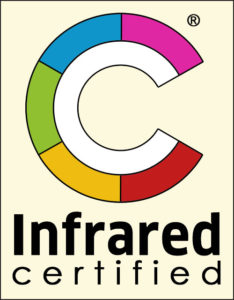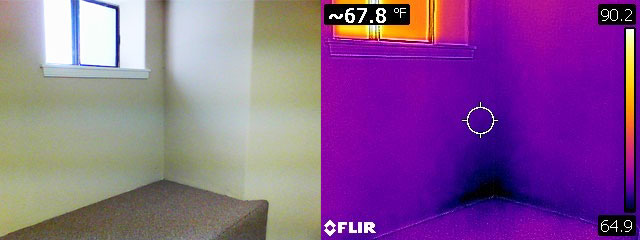Infrared Home Inspections
Signet Home Inspections
Infrared Building Inspections
Northern California infrared building inspections using Infrared thermography (IRT) takes technology invented for military “night vision” and uses it for in-depth analysis of various building systems.
Compared to seeing with the naked eye, it’s like night and day.
“Don’t be left in the dark, be sure your
building inspector is using thermal imaging.”
What is Infrared thermography?
First used in 1929 as an infrared-sensitive (night vision) electronic television camera for anti-aircraft defense in Britain, infrared thermography is simply the process of converting infrared (IR) radiation (heat) into visible images that depict subtle differences in the temperature of materials in the scene captured by a thermal imaging camera.
How can thermal imaging help in a building inspection?
Detecting the temperature differences then visually displaying them via an infrared image allows us to peer non-invasively behind walls, under floors, and into ceilings to detect problems that would otherwise go undetected to the naked eye. Temperature variations can reveal myriad issues that if left undiscovered and unattended, can cause major damage. Some of the common home inspection infrared thermal imaging applications available to us include:
- Exterior Cladding Moisture Intrusion
- EIFS Stucco Moisture Intrusion
- Air Infiltration/Heat Loss
- HVAC System Leakage
- Plumbing Leaks
- Overheated Electrical Systems
- Hydronic/Electric Floor Heat Serviceability
- Pest Infestation
What are the things thermal imaging cannot do?
Although infrared thermal imaging is a useful tool, it is nevertheless only a tool that comes with both misconceptions and limitations. For instance, infrared thermal imaging is not X-ray vision that penetrates solid surfaces. What it does is identify the heat signature of surfaces and detects thermal differences that under the proper conditions could indicate anomalies like concealed moisture, overheated electrical components and even the presence of termites and rodents. Infrared thermal imaging also does not detect mold. It does however detect the moisture temperature differences which is often indicative of condensation or moisture intrusion problems which help to facilitate mold growth.
Infrared thermal imaging does not guarantee 100% accuracy and further investigation is always required using other diagnostic tools to verify the potential problem. In some cases unless removal or disassembly of components can be achieved to validate suspicions, verification can be difficult. Conditions can also change and cause the recorded temperature differentials revealed on infrared thermal images to be different. For example, if there has been no rain for several months the infrared camera will not detect moisture from the roof leak that was previously present at an earlier time.
 Are all thermal imaging inspections created equal?
Are all thermal imaging inspections created equal?
Building inspectors will typically use a FLIR or Fluke infrared thermal imaging camera (we use FLIR), both of which are high quality instruments. But at the end of the day, an infrared thermal imaging camera is just a tool and by its very nature, is only as good as its user. So enlisting a building inspector that is certified in infrared thermal imaging and has the requisite experience is key. All Signet Home Inspectors are InterNACHI Infrared Certified® and as long as conditions are favorable, use infrared thermal imaging in various capacities as part of their standard home inspection. Although not a comprehensive thermal imaging inspection, we find it extremely useful in finding deficiencies not visible to the naked eye in specific areas of the house including the kitchen, bathrooms, HVAC and electrical systems. For those desiring a comprehensive thermal imaging inspection, we offer a discounted rate on houses up to 3000 sq. ft of $150 when performed in conjunction with our whole house inspection. It can also be ordered as a stand-alone inspection for $325.
Is it necessary for my building inspector to use this technology?
It is neither mandatory nor necessary for a home inspection company to employ infrared thermal imaging in order to perform a good inspection. But why settle for good when you can have great? The U.S. Department of energy has this to say about the use of thermography when buying a house; “In addition to using thermography during an energy assessment, you should have a scan done before purchasing a house or commercial building; even new buildings can have defects in their thermal envelopes.”
When evaluating which inspection company to use for your building inspection, consider that Signet Home Inspections uses infrared thermal imaging as a part of every inspection and the U.S. Dept. of Energy recommends a thermographic inspection when buying a house, even if it is new. Does your house or commercial building deserve anything less?





Home Inspection News
Follow Signet Home Inspections via social media.